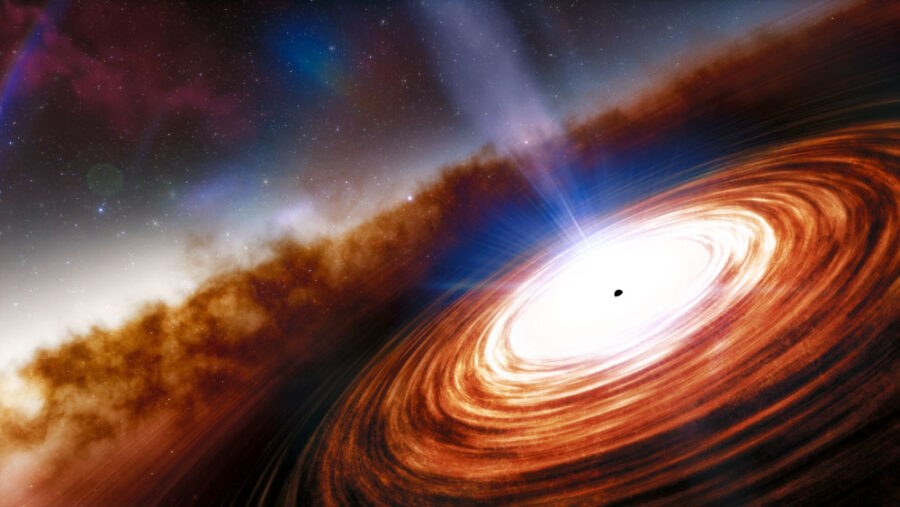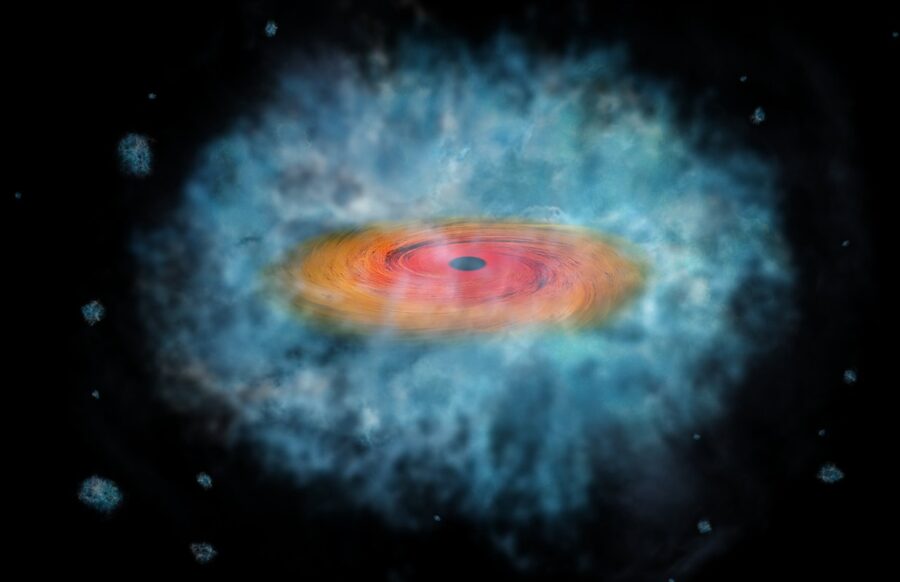The existence of a quasar when the universe was only 670 million years old is helping astronomers understand how black holes are born.

NOIRLab / NSF / AURA / J. da Silva
Quasars are the palaces of the sky, magnificent structures that surround supermassive black holes in distant galaxies. These celestial palaces must take time to build, so they shouldn’t just appear overnight. That’s why young quasars present such a conundrum. Somehow, these active galaxies manage to assemble a black hole with the mass of more than a billion Suns early on in the universe.
Now, Feige Wang (University of Arizona) and colleagues have detected a record-breaking midnight palace: a 1.6 billion solar-mass black hole just 670 million years after the Big Bang (or a redshift of 7.64) — around the era when the first stars began to shine. The result, which uses data collected by the Magellan Telescope in Chile before the pandemic began, appears in the Astrophysical Journal Letters (read the preprint online).
How to Build a Quasar
The three most distant quasars have been discovered in the last three years, and this one, dubbed J0313–1806, is only about 20 million light-years farther away than the previous record holder. But it’s twice as massive and as such, it’s making astronomers wonder just how these celestial palaces come to be built so quickly.
Astronomers have found themselves in two schools of thought regarding supermassive black hole formation. One school posits that black holes come from stars, albeit very massive ones or ones in special conditions. For example, the very first generation of stars, known as Population III stars, likely were far more massive than later generations, on the order of hundreds of solar masses. They burned fast and died young, and therefore could have been the seeds of supermassive black holes. Dense star clusters might have accelerated their growth.
The other school of thought skips stars entirely and goes for the direct collapse of cold clouds of gas, something not possible now but thought to be possible in the crowded early universe.
Learn more about the first supermassive black holes in the January 2017 issue of Sky & Telescope.

NASA / CXC / M. Weiss
The record-breaking quasar may help decide the issue. Even if this black hole were gaining mass at the maximum rate, 100% of the time, Wang and colleagues find that it would still need to have been huge — as in, 10,000 times the Sun’s mass — to weigh in at 1.6 billion Suns by the time it’s observed. Wang’s team thus rules out a massive star or star cluster for the formation of this black hole.
“This tells you that no matter what you do, the seed of this black hole must have formed by a different mechanism,” says team member Xiaohui Fan (also at University of Arizona), who presented the find at the 237th meeting of the American Astronomical Society. “In this case, one that involves vast quantities of primordial, cold hydrogen gas directly collapsing into a seed black hole.”

Wang et al. / Astrophysical Journal Letters
“I think these large masses at redshifts greater 7 put a huge amount of pressure on models that assume Population III seeds,” agrees Mitch Begelman (University of Colorado), who was not involved in the research.
“Even with direct collapse to a 10,000-solar-mass seed,” he adds, “the seed would have to grow at [the maximum] rate for the entire time.” But Begelman doesn’t rule out growth above the so-called maximum.
The maximum growth rate comes from the fact that black holes eat like the Cookie Monster —and there’s a point at which more crumbs go out than in. But Begelman and other theorists have established that, under the right conditions, black holes can actually feed at more than the maximum level. That means they don’t have to be at the maximum level all the time — they might feed at extreme rates, but intermittently.
“The problem is,” Fan points out, “so far all the quasars we’ve observed, at the times they were observed, they were obeying [that] limit.” J0313–1806, for example, is growing at just about the maximum level, ingesting 25 Suns’ worth of mass each year. Maybe at even earlier times black holes fed at more extreme rates.

Feige Wang ( University of Arizona)
The only way to find out is to go back even further. But as Begelman points out, they'll need to look carefully. “Black holes that are hyper-accreting might not look like quasars,” he says, noting that dense dust might surround these objects. “We might not be looking for them the right way!”
Outside the Palace Walls
Besides powering the most distant quasar known, the black hole at the center of J0313–1806 is also powering a gale of hot gas that’s traveling outward and into the galaxy at 20% speed of light. Such outflows might be common in the early universe, when both galaxies and their black holes were growing at tremendous rates.
But what such winds do to their galaxies’ evolution is still a matter of debate. Observations with the Atacama Large Millimeter/submillimeter Array in Chile show the galaxy that hosts the quasar is birthing stars at a rate of 200 solar masses per year. With a wind of hot gas gusting through the galaxy, that churn may grind to a halt. Then all that will be left is a massive “dead” galaxy, where new stars are a rarity, with a behemoth black hole at the center. (That is, unless another galaxy happens along to liven things up.)
 2
2









Comments
Arnaud
January 15, 2021 at 6:37 pm
Thank you for yet another very interesting article.
If we consider that dark matter is sensitive to gravity, but not to electromagnetism, then is it subject to the Eddington limit of accretion rate? I would assume not... but could be wrong. If indeed it is not, and outweights baryonic matter by a factor of 5-6, then one could conclude that dark matter makes up most of the mass of these early black holes. Would this help solving the problem of their large mass so early?
Arnaud
You must be logged in to post a comment.
Tom Hoffelder
January 18, 2021 at 11:50 am
Very interesting and makes complete sense!
You must be logged in to post a comment.
You must be logged in to post a comment.